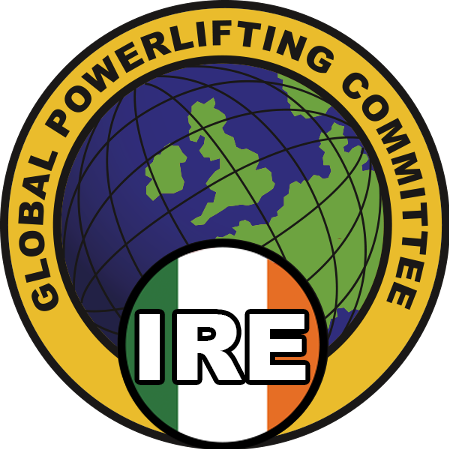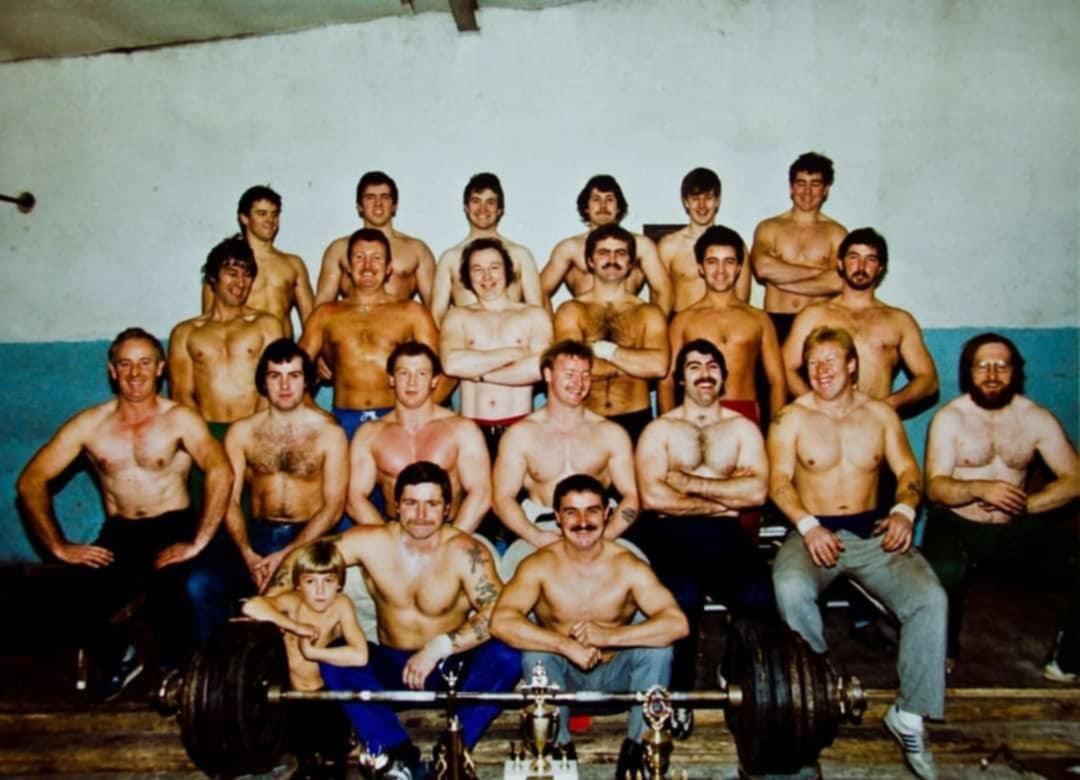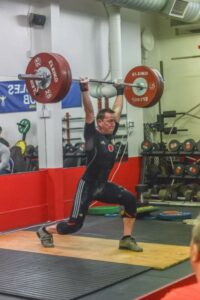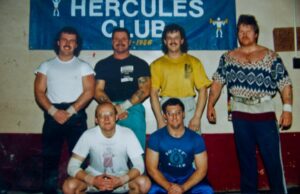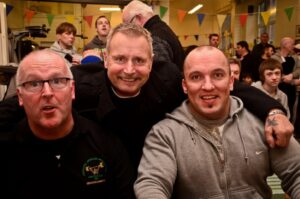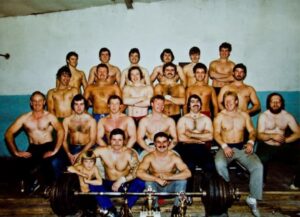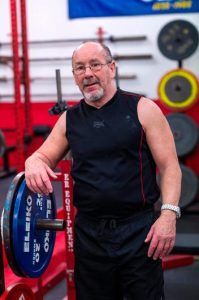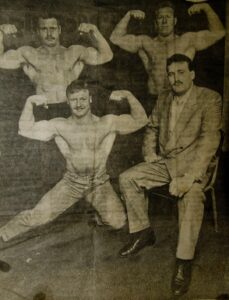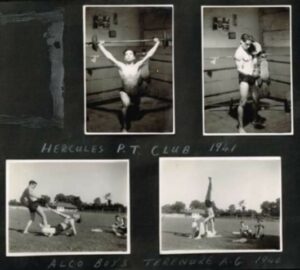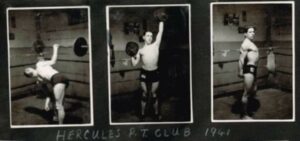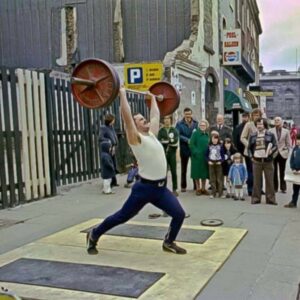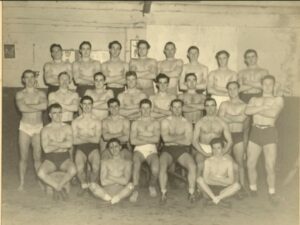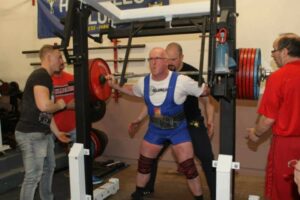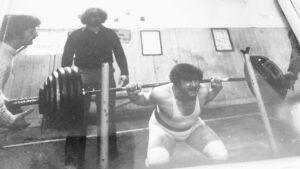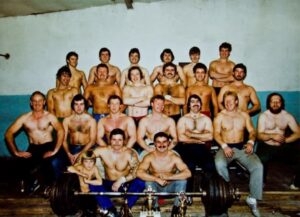I have had the pleasure of interviewing Stephen Hynes of Hercules Gym, Irelands oldest weightlifting and Powerlifting club run by its members. Stephen has a lot of very interesting stories that he would have gathered throughout the years and handed down to him by members past and present. As the gym was founded in 1935 then there is a lot that we couldn’t fit into our first of our “Specials” on gyms and lifters alike.
Our webmaster, Ed Mooney, compiled a list of questions to ask in order to do this special as without this list then we could dedicate a book to the Hercules Gym in Dublin and who knows we may do so in the future with help from all in this very important and historic club.
I do not use the word “Important” lightly here as the history of the Hercs gym ( as its commonly known ) is a history of Irish Powerlifting.
I had the greatest pleasure to compete with the legends of the sport of Powerlifting as half or more of the Irish team for international competitions, such as Celtic Nations and World Championships, would consist of Hercs members.
Legends such as Gerry O’Grady (R.I.P.), Tom Ward (R.I.P.), Ken Lawless (R.I.P.), Dave Smith and Ben Hartigan ( a Bodybuilder, Weightlifter and Powerlifting legend) and of course our very own GPC legend, Bill Healy. There are others that slip my mind of which I put down to my ageing mind.
Then there are the Hercs legends who came at a time that I took a long hiatus from the sport of Powerlifting like Ber Delaney and JJ Dunne (R.I.P.), JJ is not deceased but he switched to Bodybuilding from Powerlifting which is kind of the same thing.
As mentioned that the Hercules Club is intertwined with Irish Powerlifting history as the great Olympic lifter and Hercs club man, Tommy Hayden, was president of an emerging Powerlifting association in Ireland. Tommy was an Olympian after having competed in the 1956 Olympic games held in Melbourne, Australia. The same Olympic games that Irish Track & Field legend Ronnie Delaney won Olympic gold in 1500 metres.
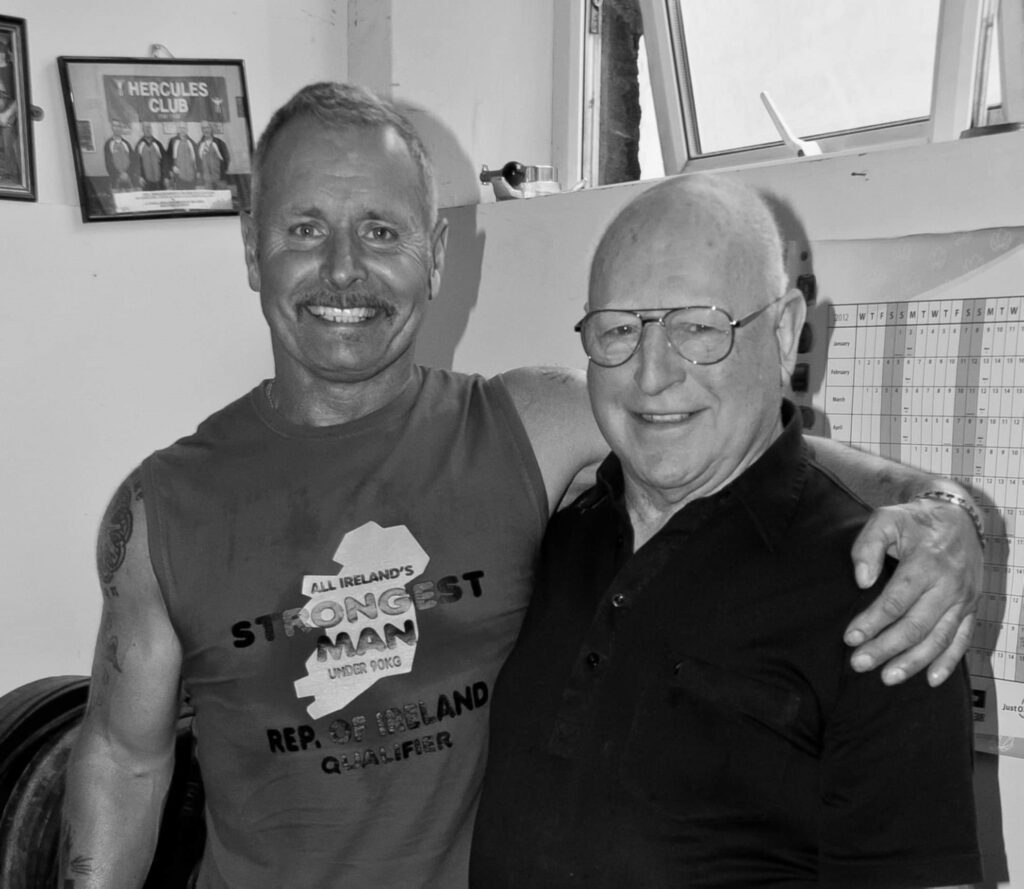
At the time I came into the sport of Powerlifting then Powerlifting was under the Irish Amateur Weightlifting Association (IAWLA), of which Tommy Hayden (R.I.P.), seen on right of photo with Ben Hartigan, was president. The IAWLA was affiliated to the British Amateur Weightlifting Association or BAWLA as its known. I remember when I joined we were given membership booklets for IAWLA which allowed us to compete nationally and internationally in Weightlifting and Powerlifting.
Powerlifting broke rank from the Olympic Weightlifters and formed the Irish Powerlifting Federation (IPF) who were affiliated to International Powerlifting Federation (IPF) but this is whole new other story.
Enough with my ramblings and lets get onto the interview between Ed Mooney and Stephen Hynes.
Q. So most of us know that the Hercules is Irelands, oldest Gym. But for anyone whom is not aware of its history, could you tell us a bit about the long history of the club. Starting with its early beginnings down on the quays? How did it get started and how have you managed to keep the doors open for so long, when many have failed.
A. The Hercules first opened its doors in 1935. An English man, George Dale, set up the club with a few friend’s in the back of an old tenement building on Ormond Quay in Dublin’s working class and poor community. They made up a few bits from what ever they had to hand. Two years later they were doing exhibitions all over showing off their lifting skills and feats of strength.
The club has endured because of its dedicated membership. The ordinary folk who just have a passion for the iron game and a love of the club. We saved a few bob over the years and in 1985 we bought the present building. We loaded up Patsy Conboys roadstone tipper truck with all our equipment which wasn’t much and we all got in the back and drove to our new club location. We made alot of the old equipment and bought second hand. Again here we are today and at 90 yrs next year we are still going strong.
Q. What’s the membership like? How many members do you have, Male/Female/Youth?
A. At the moment we have a paid up membership of about 300. We now are rejuvenating our weightlifting and Powerlifting with so many great young talented lifters.
All of this is down to a volunteer group of members that look after the day to day running of the club.. which takes up alot of time. But these guys are passionate about our club and want to see it grow and last another 90 years..as we have no staff to watch over everything we don’t have youth at the moment, but we do have qualified IAWLA coaches that are on hand to help where needed. Also we have a wealth of talent in our past lifting crew the likes of Bernie Delaney, Dave Smith, Ben Hartigan and to many too count that are willing to help any budding new lifters.
Q. The Hercules is obviously not your normal gym, what other activities are catered for?
A. The Hercules club is most definitely not an ordinary gym in any way.. its more of a big family with generations of father and sons. The Healy’s being one of many with grandad Bill and Wayne his son and Waynes kids and grandchildren. So yes we are a family. When you join you become part of our family.
Q. Do you have coaching or classes available, if so please elaborate:
A. We cater for all strength and conditioning athletes to runners, triathletes, fighters of all the combat arts. We have members that joined in the 1960s and still regularly train. I myself joined in 1979 at 15 yrs old. So yes we are Hercules lifers.
Q. So the GPC have held a number of successful powerlifting comps. What other events do you hold?
A. We have our annual club competition in December and we are hoping to revive the strong man contest in the Summer.
Q. From the pictures on the walls some amazing athletes have come through these doors and went on to achieve great success. Care to mention a few?
A. Yes we have had many great lifters starting in the seventies with Fran mc McCarthy and Tommy Ward then in the eighties Dave Smith, Bernie Delaney , Liam Doyle, Gerry O Grady, Big Ken Lawless. And so many more then in weightlifting we had Paddy Redmond , Ritchie Shakespeare. Rocky, Ben Kelly . Wayne Healy and lots more…
Q. What in your opinion have been the highs and lows of the Hercules Club over the years?
A. We only had one low point when we nearly closed back in the seventies just before we moved and the highs are every day. But if you had to nail me down I’d say the 80s and 90s were our glory days.. and we will again very soon..
Q. What does it take to become a Hercules Club Member?
A. To be a member you just have to have a want or need to improve yourself, physically and mentally. To be more than you are. Then you are welcome.
Q. Final thoughts? Insert amusing stories, tales from the past etc?
A. This is one of my favourite stories from the Hercs archives, it tells a tale of a former member from days of yore and how he was looking for something, maybe a purpose in life and how he found it, like so many of us after him and hopefully many more will in the future.
Take a few minutes out to read this and I promise you, if you have any sort of iron in your blood you will enjoy it.
The Eddie O Reagan Story
It was in the “Mail” one night, about 1937, that I came across a short letter that was to have a very important influence on my life. It was from the secretary of the Hercules Wrestling and Weightlifting Club, and advised that there were vacancies for new members. The address was at the rear of Ormond Quay, and I rambled along one night with a companion, to investigate. I had never heard of weightlifting up to this and hadn’t an idea what it was all about. But I was always interested in wrestling and was curious to see trained wrestlers in action.
With a friend I wandered down an ill-lit lane and came to a large shed built into the rear of a decrepit building facing the River Liffey. A wicket door was opened to our knock and I stepped into the club. I stopped dead at the first sight that held my eyes. A young man was standing on a low wooden platform, about five inches high, and was heaving overhead a great pile of iron. But what arrested my attention was, to my neophyte eyes, his superb physique. He wore only bathing trunks, his body was tanned and glistening with sweat, and muscles that I had never seen before, except in pictures of Greek athletes, were rippling and bulging under the taut skin. He let the heavy bar down to his shoulders, and in a quick motion dropped it to the floor with a great clanging of metal. It was probably meant to impress us. It certainly impressed me. I was an immediate and enthusiastic convert.
I joined the club that week and came three nights a week to work out, concentrating on weight training for the first few months. The premises were primitive. A wrestling ring took up half the floor area. The equipment consisted of Roman rings, a heavy punch bag, an abdominal board, and a small supply of weights and bars. There were no adjustable dumbbells, and only two or three impressive looking bells of about 50 or 60 lbs each A few skipping ropes and a large fly-blown mirror practically completed the meagre fittings. A rough-looking cold shower had been fitted in a tiny compartment off the dressing room. That was the Hercules Club when I joined it but what it lacked in fittings it made up in enthusiasm, particularly among the few devoted founder-members who had built the whole thing themselves, from nothing. They had scraped and scrounged the few bits and pieces together practically out of thin air. Considering most of them were unemployed and there were no such thing as grants or loans for this sort of effort, it was a remarkable achievement. They had even constructed a collapsible stand that was generally stowed on the steel girders of the roof. It could be assembled for a “show” and could hold about fifty or sixty people on five or six tiers.
The members were a mixed lot, from various walks of life and every age. At this time, and for some years, this club was the only wrestling and weightlifting club in the twenty-six counties, as these sports had a minute following. The club, when I joined it, had one young doctor, a seaman, a plumber, a couple of fitters, a sprinkling of clerks, civil servants, a dustman, a few factory workers, electricians, musicians and one or two with their own business. The wrestling trainer, George Dale, was an Englishman who had been bantam-weight champion of England, a first-class wrestler. There was no instructor for weights. You pottered away by yourself, depending on whether you could get a bar or enough discs, and followed one of the Bob Hoffman courses pinned to the wall. After about six months of a strenuous routine on the bars I noticed a definite improvement in my physique and a remarkable feeling of well-being and glowing health.
It was a great delight to cycle to the club after tea, spend about two or three hours training, finishing with a short wrestling session to work up a sweat and ending with a cold shower that would send blood tingling through every vein in your body. Lively and varied discussions were held in the dressing room. Diet, exercise and tales of prowess in various sports were common, especially arguments about the relative merits of old-time boxers, wrestlers and strong men. The highlights of the careers of Tunney, Dempsey, Johnson, Fitzsimons, Max Baer, in boxing; Frank Gotch, Hackenschmidt, The Terrible Turk, The Gorgeous Greek, in wrestling; Louis Cyr, Sandow, Apollon, Charles Rigoulet, Arthur Saxon, in the iron game, and many others whose names I have forgotten. The American weightlifting magazine “Strength and Health” was in great demand, and copies were forever being swapped around among the weight enthusiasts
There was always the danger of narcissism in the bodybuilding game, and particular care was taken to discourage and ridicule anyone who showed signs of the disease – spending long sessions in front of the mirror, preening and pirouetting and posing, along with exaggerated muscle fluttering. The emphasis was more on strength and ruggedness than the wasp waist and bat-latissimus types. They were vigorously discouraged. Another related passion of physical culture generally was the craze for sun tan. Once the warm weather came a number of young men chucked their job, if they had one, and spent their days basking on the rocks of Dollymount or Sandycove.
Instead of the rather aimless, though pleasant, rambling and cycling and picture-going I now gave three nights, and sometimes four, to weight-training and wrestling. I followed the bodybuilding courses assiduously and gradually worked my way into weightlifting proper. Every Saturday night myself and two other enthusiasts worked on the Olympic lifts, the press, the snatch and the clean and jerk. Although the two others were a stone or so heavier than I was, I managed to keep abreast of them and sometimes surpass their lifts. It was tremendously exhilarating to be working to ones limits, and every odd Saturday or so to put another 5lb or 10lb extra on the lift. Soon enough I was heaving overhead that magic 155lb that I had seen Al Seddon struggling with on the first night I had entered the club. I was about 136lbs bodyweight.
I kept a diary for those early years and entered the dates and poundages of all the different lifts as I pushed the limits slowly upwards, for we often varied the Saturday night programme by trying out lesser known lifts, the one- hand clean and jerk, one-hand snatch, the bent press and the two-hands anyhow. My weight increased slowly but my strength and stamina fairly rapidly. There was this incredible sense of well-being and superabundant vitality.
We put on a few outdoor shows. One, in Tolka Park, was a curtain-raiser to a wrestling match between Jack Doyle, the Gorgeous Gael, and some other behemoth whose name I have forgotten. So tyro though I was, I found myself demonstrating the Olympic lifts to a crowd of several hundreds. However, as nobody had a clue about weightlifting anyway, the sheer novelty of the thing went down well. The wrestling match between the pair mentioned was a shambles of the first order, as neither of the contestants had the faintest idea of the game and Doyle would have shoved his arse through a hoop for money at this stage of his career.
Another exhibition we did was on the invitation of some enterprising gent who was running a “fancy fair” in Rush in North County Dublin. He thought it a good advertisement to bill us around the town as “The Famous Weightlifting Team from the Hercules Club”. He offered a prize of 10 shillings to any local yokel who could lift the heaviest weight overhead. This, of course, was a great draw, for there was no surer way of attracting the young males of the rural scene than by a test of strength, as every circus manager knows well.
Well, it was quite a surprise to the few of us who travelled down by train to Rush (all fares paid, of course) to find, when we arrived, that a girl’s pipe-band had been hired to parade us in to town. And there we were, a bunch of excited young fellows marching up the main street of Rush to the tune of “all the priests of the parish won’t make me a nun”, while the juvenile population of Rush, and the canine one too, trotted along beside us, staring in wonder at the “rasslers” and strong men from far-away Dublin.
Arriving in the fair-ground we had to strip and dress in our gear under the make-shift platform. A few of us demonstrated the Olympic lifts. McSorely and another put on a rib-tickling “all-in” wrestling bout, where the yells and curses could be heard around the ground. And then, the big show, “The Strong Man Event” arrived. Unfortunately, the chap we had chosen as judge was hardly “sans peur et sans raproch”. He was an ex-army sergeant, a good fellow, but as rigid and unbending and adamant as an Ogham pillar. Tommy’s idea of the Olympic lifts would have excluded 90% of the World Champions, for if a little finger or a hair on the trapezius was out of line – – poof! Disqualified. We had enough rows over his judging in the club, but here he was, standing with his tough, pugilistic eyes riveted on nervous locals who assayed the barbell, and dismissing them contemptuously one by one.
Frantic knocks were heard from underneath the platform as some of us tried to warn him, for imprecations and threats were being bandied around by the young bulls of Rush. But Tommy never deviated an iota from his Roman code. Finally, the strongest of the contestants had hoisted about 130lbs overhead, though of course, his arms were not locked and his body bent like a bow, his eyes popping out of his bucolic head and creases up his neck like the skin of a melodeon. Tommy said “NO”, it wasn’t a proper lift. When he put the weight down I thought that he was going to assault the judge. McSorely saw the way things were going and walked over to the sweating “strong man”. “THE WINNER” he cried, raising the chap’s hand high and a great round of applause broke out around the platform. Tempers subsided slowly as the “strong man” was handed his ten-shilling note, and a few of us led Tommy away who was still protesting, “it wasn’t a proper lift”.
Notes;
“the Mail”. The Dublin Evening Mail was a popular newspaper up until the fifties.
Jack Doyle ( born Joeseph Doyle 1n 1913), “The Gorgeous Gael” was a professional heavyweight boxer, singer and actor of the forties and fifties who hailed from Cobh, Co. Cork (known at this time as Queenstown which is famous for the port where Titanic sailed from). He married the film-star beauty “Movita” who later married Marlon Brando. He said that he could fight like Jack Dempsey and sing like John Mc Cormack. Dempsey himself said the reverse was true. Incidently Jack Dempsey was Jack Doyle inspiration and hero and the reason he changed his name from Joe to Jack. Jack Doyle died peniless in 1978 from complications due to alcholism.
Tolka Park is the famous ground for soccer and other events.
The Tommy in question is, I believe, Tommy Dillon who in his final days was brought back to the club on a zimmerframe and with a leg amputated to do some exercises. (No relation to Tommy Dillon of Limerick)
The George Dale cited was the founder of the Hercules Club in 1935. He probably returned to England some years later. He remains something of a man of mystery but the club he founded endured
The above story encapsulates us all that have found the Hercules club. We all have this passion for the iron game that has been carried down the generations and hopefully for many years to come | Stephen Hynes.
My Star Rating:
5.0 out of 5.0 stars5.0Thank you Stephen Hynes for allowing us the privilege of telling a little piece of the story of Irelands greatest Powerlifting Club. It was truly an honour to write and reminisce about old pals in Power | Liam Beville
